As controversial as this might sound, the truth remains that some DAWs are better fits for certain styles than others. Different DAWs will work and operate differently, although they are all meant to perform the same task.
It is these differences that make some software better for certain classes of musicians and for certain genres/styles.
The music production world is comprised of several categories of people who approach the craft quite uniquely.
For example, there are producers who are more about sequencing and beat-making.
For producers that fall into this category, the best DAW for them will be the DAW with an interface and workflow that allows them to pattern-sequence and arrange blocks of beats more easily.
On the other hand, there are those who are more about songwriting, recording musical instruments (like the guitar), and arrangement.
For this category of producers and musicians, the best DAW will not be that whose interface focuses more on pattern sequencing.
That being said, each DAW was made with some specific intent. A typical example is the user interfaces of Apple’s Logic Pro and Image-Line’s Fruity Loops.
From the interface of Logic Pro, it is very obvious that it was designed with the singer-songwriter in mind.
On the other hand, Fruity Loops seems more like it was designed for the typical beat-maker, especially in the Hip-Hop genre.
Although it is very possible to use any DAW for any genre, some functions are just way more intuitive and easier on some DAWs than it is on others.
This brings us back to the question of which DAWs are best for metal music. We will apply the same logic and concepts when making the selection.
In this article, we will discuss in-depth, the best DAWs you can use as a metal musician or producer.
Table of Contents
10 Best DAWs for Metal
- Cubase
- Pro Tools
- Logic Pro X
- Reaper
- Ableton Live
- Studio One
- FL Studio
- Bitwig Studio 2
- Reason 11
- Digital Performer
Review of 10 Best DAWs for Metal
Cubase
Cubase is a digital audio workstation made by Steinberg for recording, arranging, and editing music and MIDI. The first version came out in 1989, and it was the first MIDI sequencer; it ran on an Atari ST computer.
Cubase is included with almost all Yamaha audio and MIDI hardware, as well as some hardware made by other companies. Upgrades to more advanced versions of these versions can be bought at a discount.
Cubase has a high-quality audio engine that can handle metal music’s heavy and complicated sounds. It also supports 32-bit floating-point audio processing, which keeps the sound quality high even after many edits.
Cubase’s interface is easy to use and navigate, which makes it a good choice for both new and experienced users. This lets people focus on their music and creativity instead of getting stuck on technical details.
Other features include:
- The comping function allows you to compare many takes and choose the best one
- Channel strip and Audio Warp Quantize tools
- Control Room offers you complete control over your monitors and other console room gear
| Pros | Cons |
| Has powerful MIDI editing | Expensive |
| Friendly user interface | Requires a powerful computer to work with |
| Has complex mastering and featuring features | Requires a USB dongle for licensing |
| Its audio recording is of high quality |
Here’s a demo video:
Pro Tools
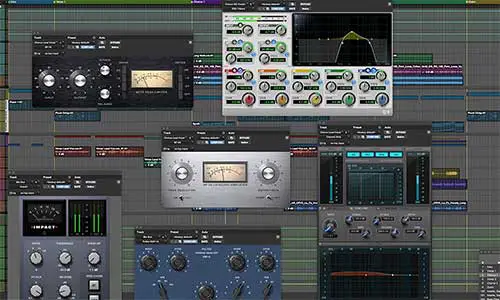
Pro Tools is a digital audio workstation made and sold by Avid Technology for Microsoft Windows and macOS.
It is used to make and produce music, design sound for movies, edit and mix audio, and do more general things like record, edit, and master sound.
The platform gives administrators a set of editing tools that they can use to cut clips, reshape sounds, and improve soundtracks.
Operators can change the timing of tracks, match up audio beats, and combine different recording takes to make new sounds. Also, teams can save presets and change plugins in real time with Pro Tools.
The interface of Pro Tools looks like a traditional analogue mixing console, which makes it easier for audio professionals who are more conversant with analogue gears to learn and use.
Pro Tools also has a lot of plugins and effects that are useful for making metal music.
For example, distortion and amp modelling plugins can be used to make heavy guitar tones, while compression and equalization plugins can be used to shape the overall sound of a mix.
Other features include:
- Explore, alter, and fine-tune MIDI performances without pausing the music, allowing you to stay in your creative zone.
- Works straight out of the pack with thousands of fascinating instrument sounds and loops to get your creative juices flowing. No need for third-party sound download or purchasing.
- Connect and collaborate with other musicians and producers worldwide to get your music heard, thereby opening up new creative possibilities.
- It is a do-it-all-in-one DAW, from recording performances and MIDI music to moulding sounds and mixing everything to perfection.
| Pros | Cons |
| High-quality audio | Hard learning curve |
| Has collaborative workflow | Can be expensive |
Here’s a demo video:
Logic Pro X
Logic Pro is a digital audio workstation, also a MIDI sequencer made especially for macOS by Apple. It was first made by the German company called C Lab, that later became Emagic, as Notator Logic or Logic in the early 1990s.
In 2002, Apple bought Emagic and changed the name to Logic Pro. A survey done in 2015 found that, after Ableton Live, it is one of the most popular DAW.
Logic Pro X is an excellent tool for producing metal music. It has a wide range of features and plugins that can be used to create and shape metal music sounds like heavy distortion, fast tempos, and aggressive drum beats.
Plugins in Pro X are effects that you can add to your tracks to change the sound. From delay and reverb to compression, distortion, EQ, Phaser, Chorus, Flanger, and more. These change your raw audio into something you can listen to.
Logic makes it much easier to change the sound in Pro X. By double-clicking on an audio file; you can open the editor window to cut, fade, slow down, and do almost anything else you can think of.
This goes all the way down to editing each waveform. In Ableton, it’s much harder to edit at this level of detail.
Also, the Logic Pro X’s intuitiveness is determined by the user’s experience level and familiarity with music production software. However, Logic Pro X is regarded as a very intuitive and user-friendly DAW.
| Pros | Cons |
| Better updated features compared to other DAWs | Expensive |
| Easy to use | |
| Has a nice library sound |
Here’s a demo video:
Reaper

Software like REAPER, which records computer audio, can be used to make, edit, change, and personalize music.
Reaper Recording Software allows you to record audio and MIDI in different formats with multiple layers. You can drag and drop to import, split, move, and do many other things in REAPER, and it has the easiest and most intuitive interface.
The load time and the number of resources used rarely change the RAM. Also, the software comes in many languages, and you can choose the language you want to use to run the software.
Reaper has many built-in audio effects and virtual instruments such as EQ, reverb, delay, compression, distortion, and more.
Reaper works with a wide range of free and paid virtual instruments. Virtual instrument plugins like Kontakt, Serum, Massive, Omnisphere, and many others can be used with Reaper.
The user interface of Reaper can be changed in many ways, and it has many features and options that let users make the program fit their needs and preferences.
Some of Reaper’s most important features are the mixer view, themes, and menus.
| Pros | Cons |
| Has a wide range of VTS plugins | Has a hard learning curve |
| Has a highly customizable UI | Limited stock plugins |
| Has flexible routing options | |
| Available for macOS, Linux, and windows |
Here’s a demo video:
Ableton Live
Ableton Live, also known as just Ableton, is a digital audio workstation made by the German company Ableton for macOS and Windows.
Ableton Live can be a live performance instrument and a tool for writing, recording, arranging, mixing, and mastering music.
The platform has a huge sound library, plugins, and an easy-to-use clip-based interface for making music, so musicians and producers can use other audio editing software.
They can sketch, change, and experiment with sounds. They can also organize music on a timeline in great detail. Musicians can record all of their ideas and turn them into music. They can manipulate audio however way they want.
Ableton Live’s interface is generally easy to understand and use. The arrangement view lets you arrange and edit your tracks in a linear timeline, while the session view is made for live performance and loop-based composition.
Ableton Live comes with EQs, compressors, reverbs, delays, and much more as stock plugins.
These plugins can make high-quality sounds and can be used to make a wide range of effects and processing techniques common in metal music production.
| Pros | Cons |
| Has a faster navigation | Expensive |
| Automation is powerful | Largely used for live performance |
| Excellent in live performance |
Here’s a demo video:
Studio One
Studio One is a digital audio workstation program that can make, record, mix, and master music and other sounds. It can also be used to make videos and comes in 6 forms.
It was first made as a replacement for the KRISTAL Audio Engine, and PreSonus bought it and put it out for macOS and Microsoft Windows in 2009.
In the last few years, this DAW has become increasingly popular, and It is now one of the DAWs that most people use.
It takes the best parts of DAWs such as the FL Studio, which focuses on electronic music, and programs such as Pro Tools, which focuses on audio.
It’s easy to build tacks with its drag-and-drop method. Version 5 added new features which include the clip gain envelopes and a score view, making live performances a lot easier.
Studio One is a digital audio workstation program with a library of instrument patches already built in. You can use different instruments and sounds to make music tracks with these patches.
Studio One is known for its easy-to-use interface and workflow, which makes it easy for users to make and produce metal music.
| Pros | Cons |
| It can be used for many music productions, not only metal music production | The interface can be damaged easily |
| Many features | |
| Very easy to learn and intuitive enough | |
| Beginner-friendly |
Here’s a demo video:
FL Studio
FL Studio is a powerful DAW that can be used to make all kinds of music, including metal. Even though metal producers often use other DAWs, FL Studio has many features that make it a great choice for this genre.
Before 2003, FL Studio was called FruityLoops, made by the Belgian company Image-Line.
FL Studio has a pattern-based music sequencer with a graphical user interface. There are four different program versions for both Microsoft Windows and macOS.
People often say that FL Studio is a powerful and hard DAW with a steep learning curve and a not-so-user-friendly interface.
FL Studio is a complicated DAW, mostly for producers with much experience. It has many features and tools that pros use, but its hard-to-use interface and high price may turn off beginners.
Unlike lighter DAWs, FL Studio is hard on the computer’s random access memory and needs at least 16 GB of RAM to run smoothly. For FL Studio’s graphic interface to work right, your screen should also have a resolution of 3840 by 2160.
| Pros | Cons |
| FL Studio is great for recording instruments and mixing them | FL Studio is tough and requires a lot of technical know-how. |
| FL Studio is more challenging to figure out | |
| FL Studio costs more money |
Here’s a demo video:
Bitwig Studio 2
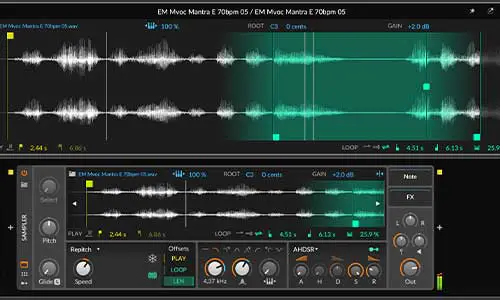
Bitwig Studio, released in 2014, initially struggled to break out from the shadow cast by Ableton Live. Indeed, much of Bitwig’s pre-release buzz was based on the idea that it was produced by a team mostly comprised of ex-Ableton developers.
When the upstart DAW arrived, it included several interface components inspired by Live. Bitwig Studio is a music creation system for Linux, Windows and macOS.
It offers an update to performance and production DAW created for recording musicians, with an easy interface that adjusts to each step of an artist’s workflow.
Some particular features of Bigwig Studio 2 that may be handy for metal music composition include:
- Drum machine: Bigwig Studio 2 includes a built-in drum machine with various drum kits that may be used to create realistic and complex metal music drum tracks.
- Virtual guitar and bass amps and cabinets: The software features several virtual guitar and bass amps and cabinets that may be used to create the best possible sound for metal guitar and bass parts.
- Automation: Automation is very common in metal music production. On that note, this software contains a powerful automation system that allows you to automate various track parameters over time, creating dynamic changes and build-ups to your metal compositions.
| Pros | Cons |
| Comes with multi-track recordings and editing capabilities | Expensive |
| User-friendly | Not beginner-friendly |
| Can support VST plugins |
Here’s a demo video:
Reason 11
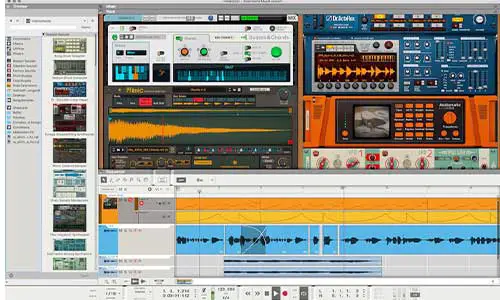
The audio engine in Reason 11 is very powerful and can easily handle complex arrangements. This is very important when making metal music, which usually has more than one track.
There are three sizes of Reason 11 packages: Suite, Standard, and Intro. All three can be used independently or as a DAW; the main difference is how many devices are included.
Reason 11 also has a lot of effects and virtual instruments that you can use to make your sounds and change them.
Reason 11 has many sounds and instruments, including guitar and bass amps, drums, and synths. This makes it easy to make metal sounds without buying expensive equipment or expensive third-party VST instrument plugins.
Reason 11 has many effects and processing tools for making metal music. Reason has everything you need to make the perfect metal sound, and it has plugins for distortion and saturation, as well as tools for EQ and compression.
The MIDI editing tools in Reason 11 are very simple and easy to use. This is very helpful for making metal music, which often needs complicated MIDI arrangements.
Reason 11 also has great tools for working online with other musicians and producers. It is great for metal bands that want to work together from different places. This DAW works on both Windows and macOS and supports several languages.
| Pros | Cons |
| Fair price | Does not support rewire |
| Quality visuals and features |
Digital Performer
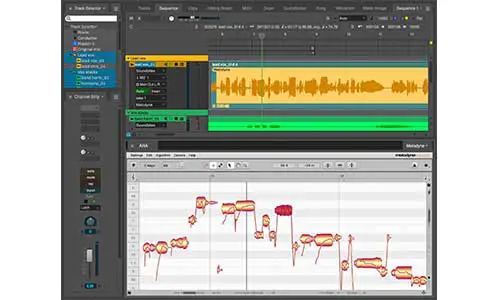
Digital Performer is a digital audio workstation and music sequencer software package made by Mark of the Unicorn of Cambridge, Massachusetts, for the Apple Macintosh and Microsoft Windows platforms.
Digital Performer gives you a full studio experience right on your computer desktop. It offers professional recording, mixing/mastering features that will in turn make your metal music sound awesome.
External hardware like mics and synths can be used with virtual instruments, loops, audio tracks, and MIDI tracks in an easy-to-use environment for making music.
Also, it works musically with tools, for example, the QuickScribe notation and switches gears for unique production with plugins like Subkick, guitar plugins and chorus.
Digital Performer is the perfect host, and it lets you play a bunch of virtual instruments and more.
Also, it has Digital Performer’s many mastering tools to make your recording sound better. DP’s user interface allows you to customize your workflow.
| Pros | Cons |
| High-advanced MIDI capabilities | Expensive |
| Has comprehensive audio editing and mixing tools | Has a steep learning curve |
| Highly customizable | Stability issues |
Can you Use Any DAW for Metal Music?
Yes, you can make metal music with any digital audio workstation or DAW. Different digital artists use different kinds of software, but most people agree that Ableton Live and Logic Pro X are both very popular.
This is possible because they can be used with virtual, electronic, and mixing pads; they can also be used live. But some DAWs may have restrictions or flaws that make them less good for making metal music.
As distorted guitars are a key part of metal music, there are better choices than a DAW that doesn’t have good guitar amp modelling or effects.
In the same way, a DAW that doesn’t have advanced drum sequencing or sampling features might need help making the complex and intense drum patterns that are common in metal music.
That being said, the choice of DAW comes down to personal taste, budget, and the specific features you want.
What is the Best Metal Music Daw for Macbook Users?
The best Digital Audio Workstation is the one that lets you make music the most. Before purchasing a DAW, a musician should look at demos of the DAW they wish to purchase.
Also, it makes sense to check if other producers in your genre/niche are using that DAW. If not, you should check out the most common DAW producers in your niche are making use of.
There are several DAWs that metal music producers who are using Macbooks use to produce. The most popular DAWs in this category are Logic Pro X, Ableton Live, Cubase, and Pro Tools, DAWS, which work well for making metal music using Macbook.
What is the Best Metal Music Daw for Widows?
Some of the most popular ones are Ableton Live, Studio One, and FL studio. Windows users don’t have as clear of a choice, but the best beginner DAW for a window setup is Ableton Live 11 Intro.
People who make metal music using windows use Ableton Live, and the fact that it works on both Windows and Mac makes it a good alternative for Mac users as well.
Ableton live stands out from other DAWs for beginners because it works quickly and easily and lets you write, arrange, and play music immediately.
What DAW Do Professionals Use?
Pro Tools is widely regarded as the industry standard in recording software, and for a good reason.
Pro Tools is a popular industry DAW for music production, mixing, and mastering.
It is a popular choice for professional studios and post-production houses due to its complete range of tools for audio editing, MIDI sequencing, and automation.
It was created to emulate a hardware studio and integrate with it to become the recording centre, so the way it works is familiar to those who are used to working with professional and analogue recording equipment.
Conclusion
When selecting a DAW for making metal music, consider how well it can record, mix, and master audio. Seek for a DAW that can handle various audio files and has powerful editing features.
It would be best if you also considered the DAW’s user interface, which can significantly impact your workflow and productivity. Also, consider the DAW’s technical assistance and online resources.
This can be useful if you need help with creating music. Finally, choose a DAW that is within your budget and provides the required tools and features to get the desired sound.

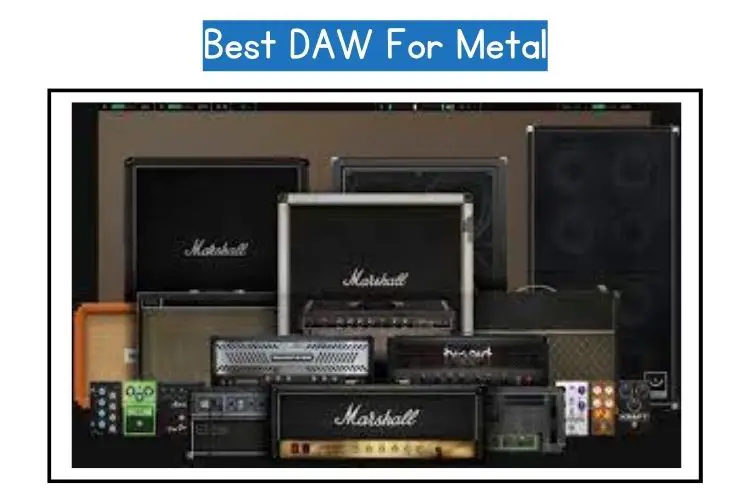
![Kaotica Eyeball vs Fatboy: ALL You Need to Know [2023]](https://performerlife.com/wp-content/uploads/2022/05/Kaotica-fatboy-211x150.jpg)

![What Happened To “Chief Keef”? [Everything to Know About This Rapper]](https://performerlife.com/wp-content/uploads/2022/05/Chief-Keef-211x150.jpg)